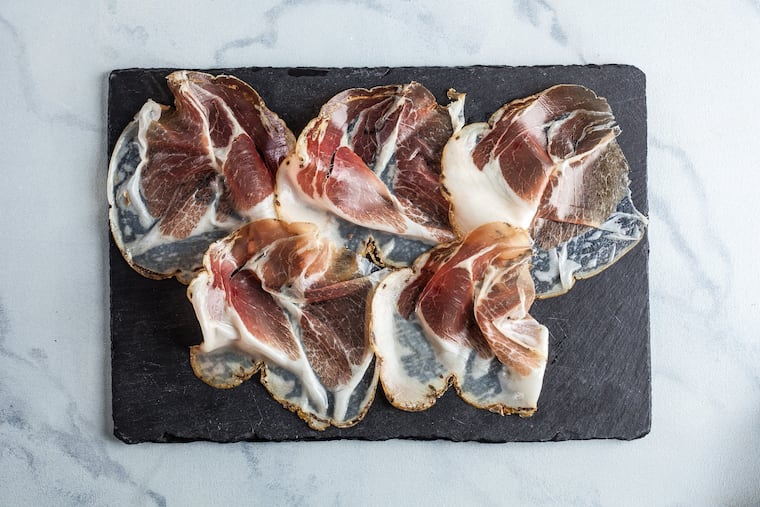For years, a cured Italian meat was banned in the U.S. The ban has been lifted — but versions made by American farmers are better
For decades, the cured meat known as culatello was banned from the U.S. Now the ban is lifted — but American farmers are making their own.

Hunter Fike of Di Bruno Bros. waited years to taste an authentic slice of imported culatello, regarded by some as the most prestigious salami in Italy.
Made with the muscle from the back of a pig’s hind leg and aged inside its bladder, culatello has been called the king of cured meats for its supple texture and rich, funky flavor that evokes a rind of cheese. Until recently, it was one of several Italian meats prohibited by the U.S.D.A. due to an outbreak of swine disease dating to the 1970s. It finally arrived at Di Bruno’s last summer, five years after the ban was lifted.
Fike, the cheese and charcuterie manager for Di Bruno’s, was dismayed to find the meat underwhelming after so much buildup, like an imitation of prosciutto. In fact, he said it wasn’t as good as culatello made closer to home — such as that from Tempesta’s Artisan Salumi in Chicago, which is available at Di Bruno’s.
In recent years, as the demand for cured meats grew from America’s charcuterie movement, butchers and farmers in the United States started making their own culatello.
Ari Miller of 1732 Meats, a company that sells charcuterie made from heritage pork, said the scarcity of Italian culatello opened the door for small producers to create products that taste even better.
“Just because something’s from Italy doesn’t mean they’re using the best pigs,” he said.
Miller has made culatello, though not recently, because of the time, maintenance, and butchering skill it requires.
“Unless you’re going to be doing a lot of it, it makes more sense to focus on prosciutto,” he said.
Culatello originated in the countryside north of Parma, Italy, where it is made from black pigs that are foragers, feasting on grass, chestnuts, and acorns — a diet that is said to give the meat its depth of flavor. They are recognizable also for the floppy ears that shield their eyes from the sun as they graze.
Described as the “heart” of prosciutto, the meat is cut from the center of the back of the pig’s thigh, then seasoned with salt and pepper, sometimes washed with an Italian wine, and encased in a pig’s bladder. It must be trussed carefully in a netlike pattern, then hung to cure for at least eight months. The meats are seasoned by the fog that rolls off the Po River every day.
“The fat-to-lean ratio is perfect,” said Joe Cicala, who makes cured meats, including culatello, with his company, Salumeficio Cicala, which sells its products to local stores. He plans to open a restaurant in the Divine Lorraine Building on North Broad Street this year. “When done well, it tastes really special.”
Some local butchers who make culatello, such as Cicala and La Divisa Meats’ Nick Macri, get their meat from Paul and Ember Crivellaro, who raise an all-black herd of pigs at Country Time Farm in Berks County. “He has the closest breed to the European version," Cicala said.
The culatello from Tempesta’s Heritage Meats is aged for almost a year with salt, pepper, and a touch of wine, Fike said. It’s best eaten with crusty bread, cheese, and maybe a glass of wine or sparkling water.
After some lukewarm customer feedback, Di Bruno’s discontinued the imported brand to focus on the Chicago-made culatello.
“Every response we got from customers on the Italian culatello was they thought it was good,” Fike said. “But there was nobody who was crazy for it. The American brand, people have been very enthusiastic about it."